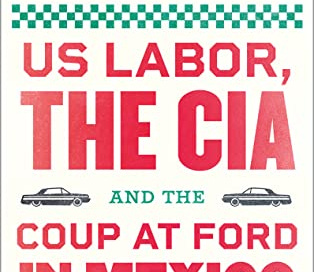Rob McKenzie with Patrick Dunne, El Golpe: U.S. Labor, the CIA, and the Coup at Ford in Mexico, Pluto Press, 2022.
On 8 January 1990, several hundred armed men marched into the Ford assembly plant in Cuautitlán, Mexico, and attacked the workers there, leaving one man, Cleto Migmo, dead and a number of others with gunshot wounds.
Rob McKenzie was an auto worker and union representative at the Ford Twin Cities Assembly Plant in St. Paul, Minnessota when the news came through. From senior officials of his own union, the United Auto Workers (UAW), he learned of suggestions that the US labour federation, the AFL-CIO, was implicated in the attack, along with the CIA. This book, written with historian Patrick Dunne, is his attempt to document that thesis.
This led McKenzie on a long and arduous trawl through the archives of the State Department, the CIA and the AFL-CIO itself. His experience with the latter suggests that even after significant leadership changes, the US labour movement has yet to fully come to terms with its Cold War past.
Perhaps its a tribute to the historic strength of the British labour movement that several of the key works on the AFL-CIO's Cold War are by British scholars, and McKenzie makes good use of the work of writers like Hugh Wilford and Anthony Carew.
One theme of that literature, which this book perhaps exemplifies as much as amplifies, is the distinct approaches to the Cold War of the AFL and CIO labour federations, traditions which persisted long after their merger in 1955.
The AFL formed by older craft unions, was anti-communist from the beginning, so much so that its activists could and did teach the CIA a thing or two. The industrial unions of the CIO, including the UAW, were initially prepared to work with communist activists. Like the British TUC, they attempted to co-operate with Eastern Bloc unions after the Second World War. The effort quickly broked down, but even when they embraced the Cold War, the CIO and the UAW brought a more independent spirit to international relations, one that stressed the distinct interests of labour.
McKenzie provides an important instance of this in his account of the formation of the American Institute for Free Labor Development (AIFLD), founded in 1961 to train Latin American trade unionists. Its role quickly became a source of contention between the two factions of the AFL-CIO. Both competing visions gave the new organisation an anti-communist role, but the original plan backed by CIO leader Walter Reuther envisaged a model 'controlled by labor, which would provide economic assistance focused on workers as the best method to fight communism.'
Instead, it was the AFL vision which won out, heavily reliant on government funding, and closely co-ordinated with government agencies, including the CIA. McKenzie devotes several chapters to the AIFLD role in CIA covert actions in Guyana, Brazil, Chile and Central America. The murder of two AIFLD workers, Michael Hammer and Mark Pearlman, by Salvadoran soldiers in 1981, contributed to growing concern about Latin America among US labour activists in the following decade. Interestingly, it was the head of another old CIO union, Jack Sheinkman of the Amalgamated Clothing and Textile Workers Union (ACTWU), who led the formation of the National Labor Committee in Support of Democracy and Human Rights in El Salvador in the months after the killings.
Reagan's Central America policy caused tensions even within the CIA itself. McKenzie includes an important discussion of Bill Casey's pressure on CIA analysts to emphasise Mexico's vulnerability to a domino effect from the region. The agency's reporting was nevertheless often of a high quality and McKenzie makes good use of archival releases in his narrative.
By the time of the Cuautitlán attack in 1990, the dominoes were all falling the CIA's way. The US government was nevertheless still keeping a close eye on Mexican labour. That much is shown by the State Department archives, though there are crucial gaps.
McKenzie views those gaps, as well as CIA stonewalling, as an element of circumstantial evidence in themselves. On this central issue, as on the plane crash that killed Walter Reuther in 1970, he navigates a judicious line in pursuing a hypothesis that warrants investigation without pushing the evidence farther than it will go.
What El Golpe does establish very clearly is the larger context - the alliance between, on the one hand, the CIA and AIFLD; and on the other, Mexico's ruling PRI party and it's official CTM union federation, which certainly was involved in the Cuautitlán attack. It is an ironic picture given the traditional AFL ideology of 'free trade unionism' independent of political control.
El Golpe is a salutary tale that will be of value to any interested in the international labour movement, Latin America or intelligence history.




